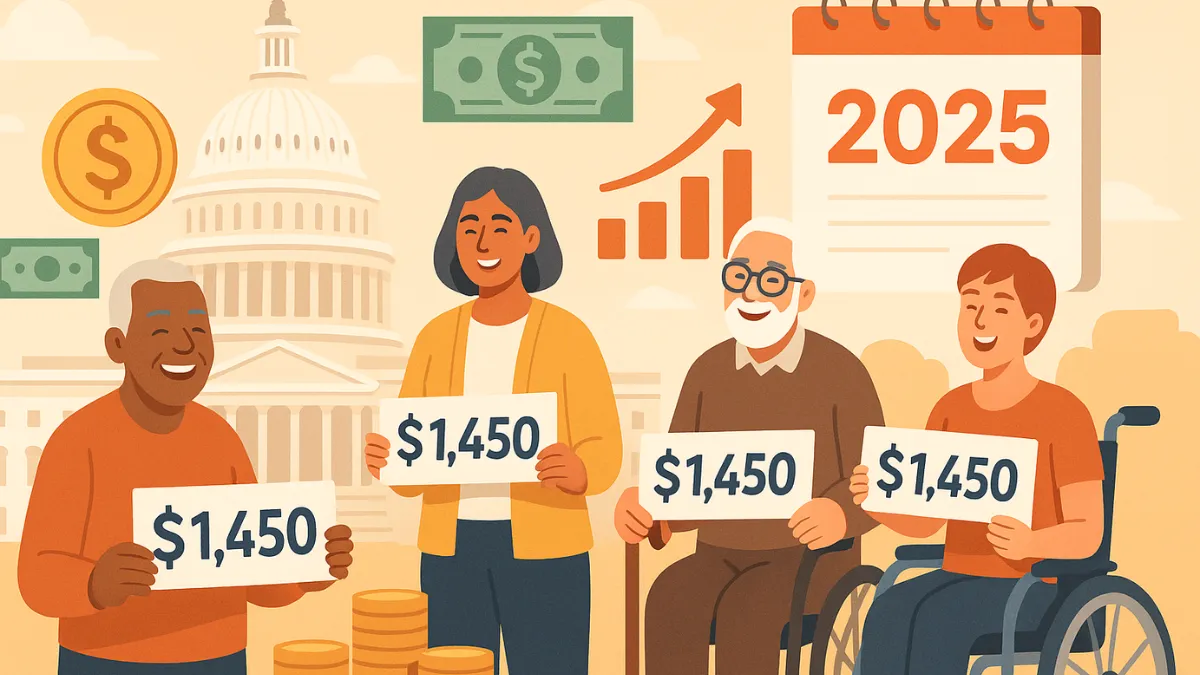SSI Payment Amounts for 2025
In 2025, the maximum federal Supplemental Security Income (SSI) payment amounts are:
- $967 per month for an eligible individual.
- $1,450 per month for an eligible individual with an eligible spouse.
- $484 per month for an essential person (someone who provides necessary care to an individual receiving SSI) .
- These amounts reflect a 2.5% Cost-of-Living Adjustment (COLA) applied to the 2024 SSI payment standards .
Who Qualifies for the $1,450 SSI Payment?
To qualify for the maximum SSI payment of $1,450 per month as a couple, you must meet the following criteria:
1. Age or Disability
Age: At least 65 years old.
Disability: Blind or disabled, with a condition that severely limits your ability to work and is expected to last at least one year or result in death.
2. Income Limits
For couples, the general income limit is $3,019 per month from work. This limit increases if parents apply for children .
Resources include assets such as cash, bank accounts, and property, but exclude your primary residence and one vehicle .
3. Residency and Citizenship
You must be a U.S. citizen or a qualified noncitizen and reside in one of the 50 states, the District of Columbia, or the Northern Mariana Islands.
How Income Affects Your SSI Payment
SSI is a needs-based program, meaning your monthly benefit amount is reduced based on your income. The more countable income you have, the less your SSI benefit will be. If your countable income exceeds the allowable limit, you may not be eligible for SSI benefits.
Some income may not count toward the SSI income limit, such as the first $20 of most income received in a month, the first $65 of earnings plus one-half of earnings over $65, and some other exclusions .
How to Apply for SSI
You can apply for SSI benefits online, by phone, or in person at your local Social Security office. It’s advisable to gather necessary documentation, such as proof of age, income, and resources, before applying.
Payment Schedule for 2025
SSI payments are typically made on the 1st of each month. If the 1st falls on a weekend or holiday, payments are made on the preceding business day. For example, in May 2025, SSI recipients will receive payments on May 1 and May 30 .
Important Considerations
Dual Eligibility: If you’re eligible for both SSI and Social Security benefits, you may receive separate payments for each program.
Changes in Circumstances: Report any changes in your income, resources, or living situation to the Social Security Administration, as they can affect your eligibility and payment amount.
Legal Assistance: If you’re unsure about your eligibility or need help with the application process, consider seeking assistance from a legal aid organization or a Social Security advocate.
Summary
In 2025, the maximum SSI payment for an eligible individual with an eligible spouse is $1,450 per month. To qualify for this amount, you must meet specific age or disability criteria, have income and resources below the set limits, and be a U.S. citizen or qualified noncitizen residing in an eligible area. If you believe you qualify, it’s important to apply promptly and report any changes in your circumstances to ensure you receive the correct benefits.
Frequently Asked Questions (FAQs)
Q1: How do I know if my income will affect my SSI payment?
Your SSI payment is based on your income, and certain types of income count toward your SSI eligibility. The first $20 of most income is not counted, and the first $65 of earned income is excluded, along with half of any remaining earned income. If your countable income exceeds the allowable limits, your SSI payment will be reduced. It’s important to report all income, including earnings from work, social security benefits, or other sources, to determine how it affects your monthly payment.
Q2: What happens if my income or resources exceed the limit?
If your income or resources exceed the limit for SSI eligibility, you may no longer qualify for benefits. Income includes money earned from work or other sources, while resources refer to assets such as cash, bank accounts, or property. If either exceeds the threshold set by the Social Security Administration (SSA), your SSI benefits could be reduced or stopped entirely. However, some assets, like your primary home or one vehicle, are not counted toward the resource limit.
Q3: Can I apply for SSI if I am not a U.S. citizen?
Yes, you can apply for SSI as a non-citizen if you are a qualified noncitizen. This typically includes lawful permanent residents (green card holders), refugees, asylees, and certain other categories of immigrants. Your eligibility will depend on your specific immigration status, so it’s important to verify your status with the SSA before applying.
Q4: How do I apply for SSI benefits, and how long does it take to receive payments?
You can apply for SSI benefits online, by phone, or by visiting your local Social Security office. The application process involves submitting documentation of your income, resources, age, and disability status (if applicable). Once your application is processed, it can take several months to determine eligibility. If approved, your payments will typically begin on the 1st of the month, with the first payment often arriving in the month following approval.

